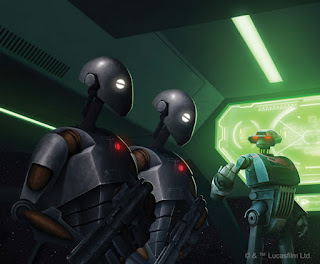 |
| Fantasy Flight Games/Lucasfilm |
Star Wars: Collapse of the Republic
Fantasy Flight Games
Developed by Tim Cox with John Dunn, Lisa Farrel, Sterling Hershey, Keith Kappel, Monte Lin, and Jason Marker
Along with the three "Essential Collection" books, Collapse of the Republic was Fantasy Flight Games parting contribution to their Star Wars roleplaying game line. Intended as a companion to their previous Clone Wars sourcebook Rise of the Separatists, this book covers the latter half of the conflict as well as some of its stranger corners. The team does an excellent job justifying the decision to split the content into two separate books. Rise gives players what they need for adventure serial influenced heroics while Collapse offers a chance to live out the darkest moments of Star Wars history.
Player characters will need every advantage to survive these bleak, final days of the Old Republic, assuming they're willing to pay the toll taken to their health, finances, and very soul.
New Faces of War
While technically a separate supplement from the first Clone Wars book, Collapse still works best as a companion to it. Whereas Rise covers all the basic careers, gear, and NPCs, Collapse takes advantage of that previous work to introduce more unique and "veteran" options.
2 new Jedi careers are offered, both rooted in seniority and experience; the very much Yoda influenced Master tree and the more martial General path, with talents that flirt with the Dark Side. The talent "Short Path to Power" is also introduced to resolve an oversight in Rise where players were locked out of building Jedi Knight's at character creation due to the Force Rank 2 restriction.
The focus on more experienced characters is also evident in the three new Clone careers: Veteran, ARC Trooper, and Clone Commander. To top it all off, Collapse introduces "Signature" abilities for Jedi and Clones.
 |
| Fantasy Flight Games/Lucasfilm |
This book also provides more universal specializations, depicting some fan favorite and very specific roles. Mandalorians finally get a proper statline with Death Watch Warrior, sporting talents that make jetpack characters even more imposing but some emphasis on the more social side of the Mando'ade as well.
Which is to say, talents to enhance Coercion.
Nightsisters also emerge from the shadows, offering one of the more genuinely unique and mystical force user talent trees. The first (and only) true Separatist specialization arrives with Separatist Commander, easing the pass for some less explored perspectives.
Collapse does run into a lot of very "similar" careers. You can make a thematic argument for the clone specializations being so similar but it's still notable how close
Commander feels to Officer, as well as Veteran's similarities to the standard Trooper tree.Conversely the Senator specialization, an interesting choice that I'm glad survived fandom grumbling about "too much politics," has talents distant enough from Rise's Republic Representative to justify the inclusion. Overall, it's a good array of specializations, both for progressing existing characters or crafting new, high level ones.
Collapse' new species lose a spot to Clones once again- a part of its conceit that this book is independent from Rise. The writers at least use it as a chance to establish how the Clones' role has shifted over the course of the war. Some interesting political ramifications, never properly explored in the other media, are raised.
The other species are an odd assortment. Dathomirians make a showing, surprisingly with their Barbara Hambly Courtship of Princess Leia background intact. Like Clones, they're similar enough to humans mechanically but then where's the room for a non-Dathomirian Nightsister?
Karakorodon and Harch are also available, shark and spider like aliens respectively introduced as cartoonishly monstrous Separatist generals in the 2009 Clone Wars show. Collapse goes at length to explore the species' backgrounds, giving a real sense of the history that led them into the War. While not totally free of it, they do tamper down on the essentialism too common with other Star Wars species. In that way, Collapse does what any EU should do, expanding otherwise one dimensional factions and characters.
The Right Tools for the Wrong Job
The gear, vehicles, and NPC section fills in most of the gaps left by Rise. In terms of weaponry, the remaining iconic Clone Wars weapons are covered, though plenty of love is given to the Mandalorians, statting out their traditional and more modern arsenal. I appreciate the restraint shown, avoiding some fans (and even writers') tendency to exaggerate the Mandalorian prowess: their armor is average, barring the appropriately absurd 5 Hard Points. Even the Darksaber is given the stats of a regular lightsaber.
Beyond the T-Visor, some other treats are slipped in. There's a decent range of attachments and some fan pleasing choices like Sabercanes and Katarn-class Commando Armor. Lightsabers get all the shine you'd expect them to have in games set during the Jedi Order's last few glory days.
 |
| Fantasy Flight Games/Lucasfilm |
Vehicles and NPCs are also satisfying, though not as impressive as the new gear. In keeping with previous publications, the NPC section doesn't play it safe: some characterful additions like Senate Guards and Nightbrothers pop up. There are still some notable gaps though. Personally I'm annoyed we never got rules for some of the more memorable droid units, specifically Homing Spider Droids. More pragmatically, this book repeats profiles for the basic Clone NPCS but the same isn't done for their droid adversaries.
Collapse of the Republic has a much more specialized focus than Rise, which I appreciate, but the lack of B1 or Super Battle Droids ensures that I couldn't run a fulfilling Clone Wars campaign with just this book.
Collapse also introduces more Iconic NPCs, drawn from the movies and the 2009 show. I've spoken previously that I've found established characters like these difficult to use. After all, the game you're running is supposed to be the players' story. Even so, it's fun to see characters like Anakin, Darth Maul, and Ashoka statted out. Some less recognizable film and TV characters at least make a showing. Characters like Aurra Sing and Admiral Trench will give campaigns a link to the "real deal," that super fans will appreciate but casual fans might not even pick up on. That they get fun talents, like Admiral Trench faking his death, makes for some interesting sessions too.
War is a Racket
The first Clone Wars sourcebook was well written but Collapse might very well be the most enjoyable read to come out of FFG's time with the license. The themes of the era are perfectly captured, particularly the prequels' Bush-era commentary. As the war rages on, each sides' true colors emerge, with the Republic sacrificing liberties for military advantages (as well as more secretive agendas) and the Separatists fully succumbing into being a corporate oligarchy preying on planets left behind by the larger galaxy.
The economic factors of the conflict are properly explored, as the predatory greed of every galactic power has done as much damage as the actual conflict: at least when the two aren't intertwined. The book highlights this especially with the Clones, who grow increasingly troubled with the Republic they're programmed to serve and even their own existences. It's repeatedly reminded that no mater what small allowances the Jedi or the Senate scrape up, their makers still see the Clones as a product line, meant to be expended in war.
Coupled with that is a comprehensive view of the war's progress. Even as the Republic presses the advantage, the Clone Wars seems to have no end in sight, with faltering peace attempts and intensifying propaganda. Collapse replicates the mood of Revenge of the Sith, while carving out a world rather than info dumping.
 |
| Fantasy Flight Games/Lucasfilm |
Some planet profiles are provided, this time for Coruscant, Felucia, Mandalore, Dathomir, Kashyyyk, and Utapau. Once again this is the weakest part of the book, without much to offer in the way of "new" story content. The pre-written scenarios are also weak though with some interesting new NPCs, most notably the fearsome Terentateks.
While both Rise and Collapse mainly focus on the TV show and the movies, this book overflows with references to decades of tie-in media. West End Games, Bantam Books, Dark Horse comics, and more are all alluded to or even shaped into story hooks for your table. Collapse feels like a celebration of the Expanded Universe as a whole, while also leaving plenty of juicy story hooks for your table along the way.
The last portion of the book gives more direct advice to players and game masters, useful information for capturing the bleak, war time bleakness of the era. Advice is given for campaigns that reach Order 66 and how to navigate potential Player-Vs-Player situations. Unfortunately, the advice is "don't do it and have the clone PCs stay loyal" though I understand the hesitation to encourage anything more than that. A sidebar introduces the atmospheric rule "The Dark Side Clouds Everything," giving Destiny point pools a minimum number of dark side at the start of each session.
It's an excellent way to leverage one of my favorite mechanics and channel the atmosphere of the era. Mass combat rules are also provided, excellent for simulating the gigantic battles that characterize this era while also giving the various officer characters a lot more to do.
End of an Era
 |
| Fantasy Flight Games/Lucasfilm |
Overall, Collapse of the Republic is a must buy for anyone planning to run a Clone Wars era game. Rise of the Separatists creates a firm foundation but Collapse provides many of the more unique elements that's earned the era so much fondness from fans. I'll admit that this being the last non-compilation sourcebook FFG ever published adds a certain melancholic feel to Collapse. One very appropriate for the end of the Clone Wars and beginning of the Galactic Empire.
No comments:
Post a Comment